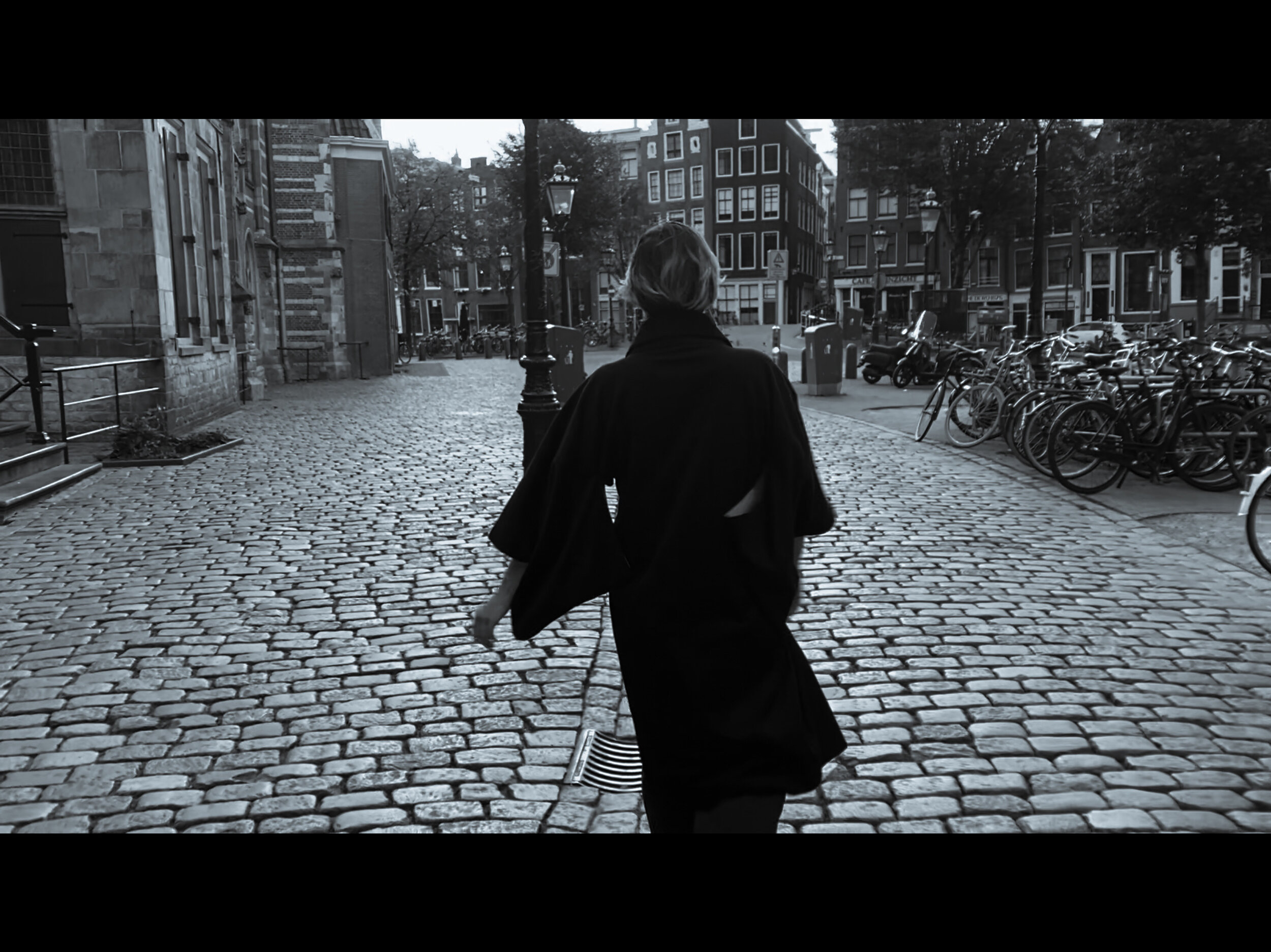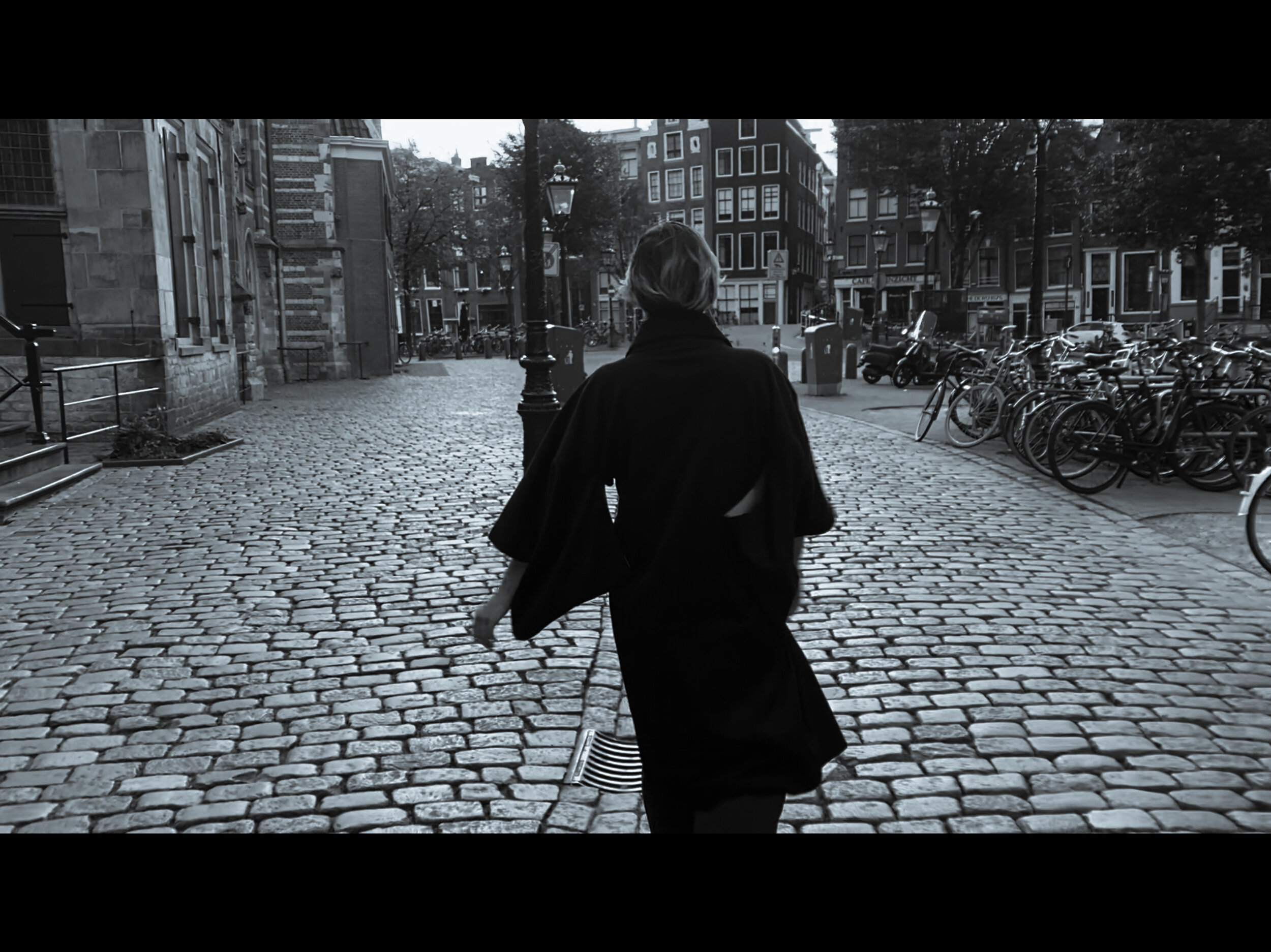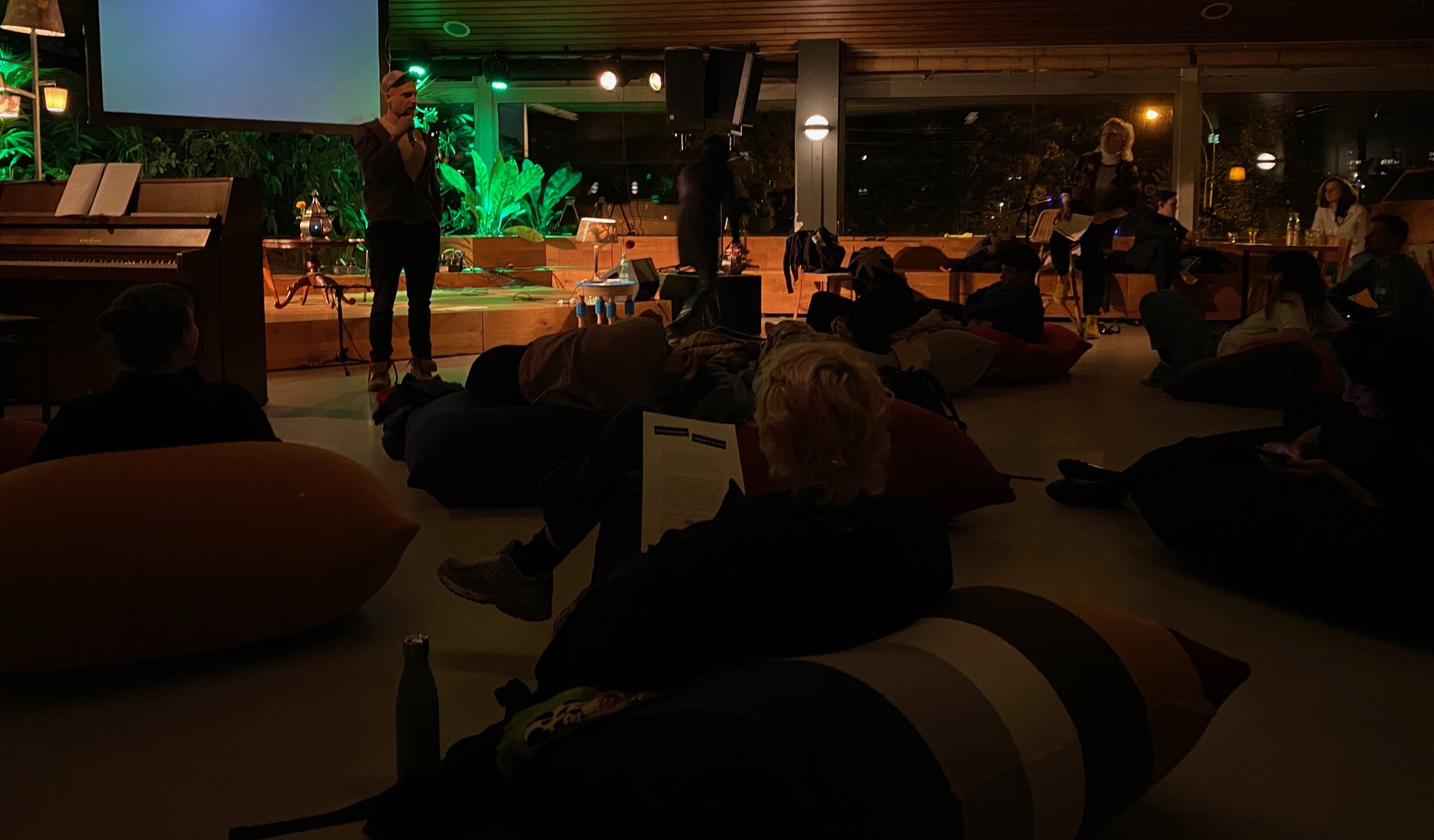it is never just process

Defining my practices has been a constant journey, a never-ending process. From reading to writing, editing content to curating cultural programmes, creating images with digital and analog tools, translating in and outside the book, communicating content, and collaborating with people and institutions; all these practices exist and move together. They are not only complementary, they push me to always think beyond one field, one art form, one media as I build work that connects all the dots of my imagination, concerns, and interests.
fragment from a novel in the making (film still). image by daan brâchel)
My biography
—from the identities I was born with to those I have accumulated through the years,
to my experiences and the knowledges I gather—
is always at the centre of my practices.
I want to share examples of projects I have developed recently, going through the process of their creation from the initial idea to its materialization, as a way to show that the process itself is a key part of the work created.
example 1: Language of the Flesh (Read My World)
I have been a programmes curator for the Read My World international literature festival in Amsterdam since 2018. This year sees the fourth edition I have been working on with a very unique team of people not only knowledgeable and passionate about literature and storytelling, but also capable of creating the safe space for many perspectives and stories to exist, develop and thrive. The way we think about programmes for the festival is not based on the literary industry’s calendar of releases, which gives us enormous freedom to move beyond more traditional formats of presenting literature on stage. To me, curating cultural and literary programmes most of the time follows a similar process to my writing. I am telling a story based on initial ideas and thoughts I have, on a subject I am interested in, then I find the people who also share the same urge to explore certain themes. The space I create on stage - the format, the concept, the audience - is then passed on to those writers and artists to make theirs.
I have started curating Language of the Flesh for the first time in the 2019 edition of the festival, and this year sees the third edition. And it all started with a post on social media.
“Aimer quelqu’un « par la chair » est une manière d’aimer, ou de parler, qui en vaut une autre, ni mieux ni pire, mais en réalité qui a sa place à certains moments, comme à d’autres moments il faut parler, mais irremplaçable et qui a sa fonction propre. Pour en revenir à mon personnage, la question est de savoir s’il a d’autres moyens que celui-là d’avoir un rapport d’amour avec les autres ; pendant toute la durée du texte, précisément, il explique pourquoi tous les autres moyens lui ont été ôtés ; il y a un degré de misère (sociale, ou morale, ou tout ce que tu veux) où le langage ne sert plus à rien, où la faculté de s’expliquer par les mots (qui est un luxe donné aux riches par l’éducation, et voilà le fond de la question) n’existe plus. On, (crois-moi sur parole !) il y a parfois un degré de connaissance, de tendresse, d’amour, de compréhension, de solidarité, etc... qui est atteint en une nuit, entre deux inconnus, supérieur à celui que parfois deux êtres en une vie ne peuvent atteindre ; ce mystère-là mérite bien qu’on ne méprise aucun moyen d’expression dont on est témoin, mais que l’on passe au contraire son temps à tenter de les comprendre tous, pour ne pas risquer de passer à côté de choses essentielles.”
French writer Arnaud Maïsetti shared, as part of his ongoing work and research on Bernard-Marie Koltès, a quote from Koltès that shook me to the core as it came precisely at a moment when I was reflecting and researching on the very subject he mentions. In a letter to his mother (1977) Koltès expresses his thoughts on “loving someone through the flesh”, like he writes in his opening line (see the quote in French which I copied into this post), exploring the possible depth in connecting with a stranger for one night, and how words sometimes lack and that the body is there to express certain things, creating a language… a language of the flesh. This quote came as a direct answer to all my questions about sensual connexions, about the many meaning and possibilities of love, and the too many taboos around sexuality and the way we are allowed to express and act on our desires. It was one of these key moments when theory and experience suddenly clash and embrace. It’s at that exact moment of reading the post when I thought: I want to translate this encounter onto the stage. And Language of the Flesh was born. I also have to add that I have a particular love for Koltès’s work, which I had the chance to perform when I was still working in theatre in my University years.
The first edition of Language of the Flesh remained very theoretical (even sociological) because of the format which I, in hindsight, think wasn’t ideal for what I wanted to achieve. The writers were all brilliant thinkers and creators, and the host was an excellent and knowledgeable journalist; but by formatting the event as a panel, I have pushed the conversation into an interesting but more traditional discussion which didn’t allow that deeper connection ‘to the flesh’ - neither for the writers nor for the audience. It was intellectually enriching, but it wasn’t the emotion I was going for. I wanted the audience to feel the shivers I felt when reading Koltès’s quote.
I have learned from this moment and for the second edition, I decided to work with a storyteller and musician to host the evening, and have asked the writers to perform a new piece or, in the case of one writer who didn’t have time to produce a new piece, enter in a conversation with the host. I have also worked on the whole setting for the audience, instead of a traditional seated room, I have asked for cushions for everyone to lie on (I cannot thank our head of production enough, she went through many efforts to make it happen!) I have also worked with the technicians to ensure we have dimmed and warm lights to create a cozy atmosphere. And all the speakers were spread across the room (this was also partly because of the COVID restrictions). The event was part performance, part conversation, all weaved in through storytelling and music. I loved it! To me, it was exactly what I dreamed of. We finally captured the emotion I felt when reading the initial quote.
I am now in the process of organising the third edition of Language of the Flesh. Although I was happy with last year’s work, and I found the connection with the audience worked really well and the texts, conversations and music all went hand in hand to create a wonderful and deep programme, I - and the speakers too - was missing a connection between the writers and their stories on stage. That connection will now happen, hopefully, in this third edition. This is the reason why I decided to work with the same storyteller and musician to host the night, because he understands process and the importance to try and share as much as I do. That click, that understanding within artistic collaborations is also key and shouldn’t be underestimated even if you are a programmer and not an artist yourself.
I like using this example to illustrate how I curate cultural programmes because it highlights the indispensable role of process. It starts, just like when I write, with a concern, a question, an interest, an obsession… Then it moves into research and collaboration, to conversations, always tapping into experiences to then create the space for imagination to exist and transform into inspiration and possibly too, into a discourse.
Language of the Flesh in 2020
example 2: fragment from a novel in the making
As another way to illustrate process and movement between media and spaces, I would like to share a very recent example of work. I have started writing a novel - the story has been in the making for years: in my notebooks, started and unfinished documents, script outlines, proposals, audio recordings… - and for the first time, I have decided to stop lose myself over the medium and focus on the writing. The story will unfold into a novel.
A few weeks ago, I was commissioned by the Kollektiv Sprachwechsel based in Vienna to write a piece for their Literature Festival Bridging The Tongues and to participate in their programme. I have worked with the collective in the past, taking part in one of their workshops, Locations exploring writing as a multilingual creator and writer. It was therefore a joy to accept this invitation and present new work. I also feel lucky that it arrived right when I started working on my novel and, unlike the writers who prefer not to share their work too early, I, on the contrary, look for the possibilities to share the process. I have therefore sent a fragment from the novel in progress as my piece.
The challenge, however, was not the writing but the other request from the festival. Because the programme will be hosted online (mainly because of COVID), the organisers asked all writers to prepare a video reading of their fragments. At first, I thought I would read out loud and in some way either film myself or make a collage of images I feel speaks to the content (it is something I have done often as part of my video work). It didn’t go that way at all. Although I am usually at ease moving from one media to another, from the analog to the digital and vice versa, I couldn’t even read my prose out loud, and I am used to performing my own work.
I was suddenly hit by how sensitive this text was to me, and how fragile it still was (and maybe that’s why many writers don’t share their work at such an early stage). But I was also convinced that my process could contribute to the wide discourse the festival wants to create on multilingual writing and thinking. That’s also when I realized the richness of my hyphenated identities, experiences, and skillset: I was going to move within the text and translate the emotions by making certain choices. First, I decided not to narrate myself but ask my beloved and partner to do it for me. Seeing the autobiographical and raw content of my text, having him narrate the text created an extra layer of connection which I didn’t really think would be possible (and here I link my thought process to the previous example of ‘language of the flesh’ - through this process, our flesh also reconnected on another level). I have also asked him to film me and we went to shoot videos in the Red Light District of Amsterdam on a Sunday morning at 7 am so that we could film freely while the sex workers were not standing in their windows. We also went to shoot at the zoo the next day. I wanted to create strong contrasts that I feel work with the content created.
It took me days before I could make a connection between the footage, the narration, and the creation of a short film, which will be shown for the first time at the festival on 24 September 2021. In the end, we made something out of all this material. The video is imperfect - if I had the means, I would hire a professional video artist and editor, but I worked with the resources in hand. More importantly, the process itself - to me - also reflects the layers I try to capture in the text. And this experience will allow me to move to the next level and inform the rest of my writing.
fragment from a novel in the making (film still). image by daan brâchel)
Both examples reflect the importance of process and how every piece of inspiration, writing, every image, and reflection feed each other and allow to evolve. This is why I find it essential to create as many spaces as we can where such experiences and experiments are possible. Whether I curate a cultural programme, I shoot and edit a video, or write a novel, I need to share this process and all the learning that comes along, so that I myself can evolve every step of the way.
Writer, Literary Translator, Artist based in Amsterdam.
Canan (she/they) publishes a newsletter and podcast titled The Attention Span, taking the time to reflect, to analyse and to imagine our societies through writing, art and culture.


